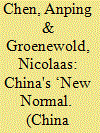| Srl | Item |
| 1 |
ID:
161812


|
|
|
|
|
| Summary/Abstract |
The extent and persistence of the inequality of regional output is an important policy issue in China and its sources have been the subject of considerable empirical research. Yet we have relatively little empirical knowledge of the effects on the regional distribution of output of shocks to national macroeconomic variables such as GDP and investment. This is an important gap in the empirical literature since much government macroeconomic policy seeks to influence GDP using instruments such as investment expenditure. It is likely that such national shocks will have differential regional impacts and so affect the regional output distribution. Policy-makers need to know the sign, size and timing of such effects before making policy decisions at the national level. We simulate the effects of aggregate shocks on individual provinces' GDP within the framework of a vector autoregressive (VAR) model restricted in a manner following Lastrapes (Economics Letters, 2005). We use annual data from 1980 to 2012 to estimate the model which includes 28 of China's provinces and simulate the effects on provincial outputs of shocks to aggregate output and investment. We find great diversity of effects across the provinces with discernible geographic patterns. There is evidence that output shocks benefit coastal provinces with developed industrial structure, export-exposure and less reliance on SOEs; the opposite is found for the effects of an investment shock and we conjecture that this is likely to have been the result of the strong bias in central government investment policy in favour of the interior provinces during a substantial part of our sample period.
|
|
|
|
|
|
|
|
|
|
|
|
|
|
|
|
| 2 |
ID:
170339


|
|
|
|
|
| Summary/Abstract |
China's ‘New Normal’ has been much discussed in recent years. An important aspect of the New Normal is the growth slowdown from levels of around 10% per annum to a more modest 6 or 7%. Not surprisingly, there has been widespread discussion of whether the slowdown is permanent or not and, in either case, what the sources of the slowdown are. However, much of this discussion has been based on informal analysis of the data rather than formal econometric results. We make a move in the direction of formal empirical analysis of this issue by estimating and simulating a vector autoregressive (VAR) model which distinguishes between demand, supply and foreign shocks as possible drivers of changes in economic growth. We analyse both two-variable (growth and inflation) and three-variable (foreign growth, domestic growth and inflation) VAR models and identify demand, supply and foreign shocks, using a modification of the Blanchard-Quah identification procedure. In the two-variable model we identify two shocks (demand and supply) and find that the slowdown since the GFC has been mainly supply-driven. This conclusion is not changed when a foreign growth variable is added to the model and a foreign shock is allowed for – we find that demand continues to be of relatively little importance, that the foreign shock also makes little contribution to explaining the long-run growth decline in China which continues to be driven by long-term supply factors. This conclusion is robust to a number of alternative formulations of the model. Thus, the growth slowdown may, indeed, be characterised as the ‘New Normal’.
|
|
|
|
|
|
|
|
|
|
|
|
|
|
|
|
| 3 |
ID:
093837


|
|
|
|
|
| Publication |
2010.
|
| Summary/Abstract |
While China's growth has been spectacular over the past 30 years, it has masked growing underlying disparities in the regional distribution of income with coastal provinces growing at a much faster rate than the rest of the country, exacerbating already marked differences in per capita income. Policy focused on addressing these growing disparities has had to face the possibility that spreading growth more evenly around the country will require a sacrifice of the national growth rate. Yet there is almost no empirical evidence that this is so and, if it is, how big the required sacrifice is. This paper contributes to filling this gap by analyzing the relationship between aggregate growth and the inequality of regional output distribution. We use a VAR model to simulate the effects over time on growth of a reduction in inequality and also the effects on inequality of an increase in growth. We find, first, that in the long run a more equal distribution can be obtained without a growth sacrifice. Second, in the short run a reduction in inequality reduces growth. Third, in the short and long runs an increase in growth actually reduces inequality.
|
|
|
|
|
|
|
|
|
|
|
|
|
|
|
|